From Mav: In one of my favorite recent comics, Batman #37 by Tom King, Batman and Superman are discussing the crests on their shirts. Superman tells Batman that S on his isn’t really an S. It’s a Kryptonian symbol and it stands for hope. Batman responds that “the bat stands for a bat.” I love it because to me that exchange epitomizes everything about those two characters and their relationship over the past 80 years. However, it also makes me think of the power inherent in what are arguably the two most recognizable “symbols” in the history of the planet. Seriously, I’d argue that the Superman S and the Batman bat are up there with the likes of the Christian cross and the Nazi swastika (I never said they were all good) in global recognizability. What I’m saying is, to slap that symbol on something sends a message. To wear them on your person makes an implied statement about you to anyone else who you might happen to encounter that day.
And I think there are levels of symbols. Of the four I mentioned before, I’d argue that the S and the swastika are probably somehow at least slightly more “powerful” in some nebulous sense than the bat or the cross. And by extension, I feel like the bat and the cross have a slight edge over… I dunno, the X-men X and the Star of David. It’s kind of silly to try and rank them all. No two people would ever agree on the rankings of every symbol ever. The point I’m trying to make is that there *is* a power to the symbol that is a mixture of its design aesthetic, its recognizability and the specific ideology that it stands for. No matter what your personal tastes or belief system, I think most of us can probably agree that eye of Dr. Druid or the Awen sigil of… well, actual Druidism, just don’t have the kind of cultural capital that anything else I’ve mentioned already does.
One of the most interesting things about communication through symbols is that the meaning inherent in them isn’t just built by the person using the symbol. It has as much to do with the person viewing the symbol as well. I once got into a political argument with a cop on Facebook about #BlackLivesMatter vs. #BlueLivesMatter where he was trying to argue that cops don’t disproportionately kill black men and that they needed to have the discretion to discharge their weapons whenever they felt their safety was threatened. My counterargument was that it was hard to take his sense of professional discretion even remotely seriously when he had chosen a #BlueLivesMatter Punisher logo as his Facebook avatar, because no matter what he says, it’s always going to come across as “and also, I want to set myself up as judge, jury and executioner, because I like to kill people for funsies!” He tried to defend the icon by saying that it just meant that he was a fan of the character and implied nothing about his personal values. I retorted that it implied EVERYTHING about his personal values, because that is the image that he has chosen to announce himself and associate his identity with and therefore he bears all the semiotic baggage associated with it by anyone who comes into contact with him and sees it. Also, I’m kind of a dick.

The thing is, that’s how symbols work. Obviously, he used that icon because he felt that doing so could announce to the world that not only does he believe in the police, but he’s also a comic book fan, particularly of the Punisher. Honestly, there’s nothing wrong with either of those things. However, by associating them together and forcing those who encounter you to make assumptions about you based on the symbol, you inherently imply to anyone who knows anything about that character and/or the history of systemic institutional racism in this country that you like to shoot first and ask questions later. Even if you don’t, your personal values are simply overwritten in the statement by the symbol that you have associated yourself with. It doesn’t matter what you personally believe. This isn’t limited to comics. The religion of Jainism dates back 1500 years. It is founded on tenants of peace, meditation and non-violence and frankly is quite lovely. However, when most westerners look at the flag associated with it, the first thing they notice is the swastika in the middle of it. The Nazi associations with the symbol simply overpower anything else that a devotee of Jainism is going to say… before he even speaks.
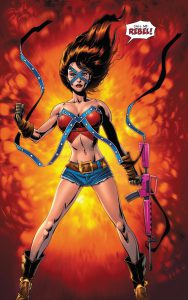
And that is the power of the symbol. We see before we hear. The same thing happens with anyone waving a Confederate flag. Babble all you want about Southern Pride or your love of The Dukes of Hazzard. Whatever your reasoning for liking the Confederate flag you have to accept that by using (or even more so wearing) it, you are making a a statement to others about yourself. And if you don’t know that statement implies racism then frankly… you’re an idiot. Even if you want to say that’s not how YOU mean it, to not understand that it doesn’t carry that meaning to a large percentage of people who see it simply makes you dumb. So to use that symbol or something derived from it means that you either are accepting the responsibility for constantly defending it and trying to explain your lack of racism (and then you have to ask yourself is it that important to you and if so why) OR you simply need to admit that you chose the symbol for yourself specifically to trigger people who are bothered by it… and as such… well, that’s kinda part of what racism is. There’s a comic book called AltHero that is… exactly what you think it is. A bunch of Comicsgate yahoos trying to be provocative. Don’t bother looking for it. If you’re a fan of our show you won’t like it. I’ve read it because it’s my job. One of the characters is called Rebel… a good’ol superpowered southern redheaded girl who exists to celebrate (not parody) stereotypes of sexy Southern pride… and PWN the libs! That’s what she’s for. They’re honest about it. Her outfit is a pair of daisy dukes, a pair of cowboy boots, and a confederate flag halter top. But at least it’s honest.
Because the Rebel only exists in order to derive the power from the symbol. She’s not even the main character of the book, and yet she was all over the marketing material when the publishers were running their crowdfunding campaign. Because the entire point of the character is to trigger the libs… and to entice those who WANT to trigger the libs. That’s the message sent by how she looks. Because no one knows what the story of AltHero is… and frankly… pretty much no one even cares… . Pretty much all of its press, both positive and negative, was generated by the association with the symbol and the controversy surrounding what they were doing. That was representative of the message that the book wants to present. This carries forward in other ways as well. Last year I bought a purple T-shirt with a yellow bat on it… my wife, Stephanie, and my mother, Lynn, both thought it was a Batman shirt. I said (with feigned indignation) that it absolutely was not. I instructed my mom to show my 8yo niece and she said “don’t be silly, Grandma! That’s a BatGIRL shirt! You can tell because the shirt is purple and the bat is yellow.” Because my niece has extra bits of domain knowledge that her aunt and grandmother don’t, she’s able to get an extra bit of meaning from the shirt. But, I’d be lying if I said I didn’t expect other people to make the Batman connection. Of course I did.
In fact, the entire reason Batgirl exists and dresses the way she does is to inherit some of the power that is already tied to the symbology associated with Batman. This is also how cosplay works. As we’ve talked about on previous episodes, there’s an psychological power that comes along with wearing a superhero outfit. You take on as aspect of the identity. One my favorite books on the power of costume, Barbara Brownie and Danny Graydon’s The Superhero Costume: Identity and Disguise in Fact and Fiction talks about the phenomena where children are less risk averse when simply wearing a Superman t-shirt, even if they aren’t specifically cosplaying at the time… and who among us didn’t once think they’d be able to fly by tying a towel around their neck?
And this goes for other clothing too. The work of Roland Barthes, one of my favorite theorists, talks about the meaning encoded in women’s fashion. There’s an implied meaning behind “the little black dress” and there’s a reason that it is worn to different functions than the pants suit is. There’s an implied difference between a bikini top and a bra, even if they are nearly visually identical. As we discussed way back on the She-Ra and the male gaze episode, the very act of wearing a skirt, signifies a statement about gender. The same is true of men’s fashion. A tuxedo and a three piece suit are near identical garments, but the act of wearing one over the other makes a different statement. It announces something to the viewer. Just to not pick on conservatives for A SECOND, there’s a real and legitimate reason that Obama’s brown suit caught the attention of people who wanted to make a scandal of it. It did not project the image that he probably wanted it to… at least to many people. It wasn’t presidential. It didn’t project the strength traditionally associated with the office. And to pretend that that is not true is ignoring the (super)Power of Fashion. Of course, so is pretending that having the president wear a #MAGA hat isn’t just shy of having him walk around with a confederate flag and swastika on his head. I said just for a second.
Anyway, I want to talk about fashion and symbolism in this next episode. How does how we dress (either real people, or fictional ones… and either real clothes or even just how we present ourselves on the net) affect the impression you have of someone? If you see someone with a superhero symbol of some sort do you immediate associate them with the character they are borrowing it from? What about other iconography like the MAGA hat, or (say a Nasty Woman or BLM t-shirt) or even something like a little black dress?

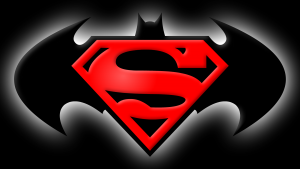
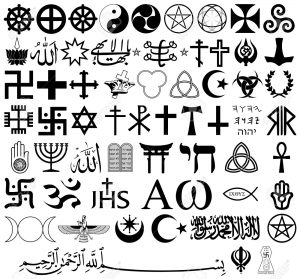
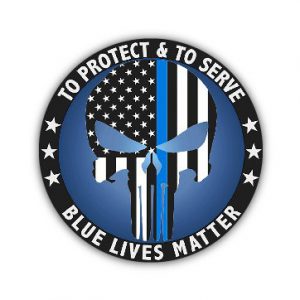
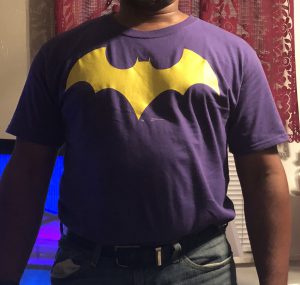



Interesting points you make. Just wish you could use fewer words to make them!!
I wanted to contribute something to this line of thought, but you hit all the points, Mav. I knowingly rock several logo tees but often they don’t have as much public recognition as Bats or Supes. (Green Lantern, Sinestro, Decepticons, Cobra, the Venom spider, Daredevil’s DD, etc.) I try to stick primarily to original coloring and design to avoid issues with double meanings, I.e my Punisher tee. I’ve always showcased my geek cred because it heralds the type of conversations you can expect from me. And within Fiction, like you said the power of a symbol is that it potentially can represent an idea so well it’s more effective than who’s wearing it. The passing of the mantle as it were.